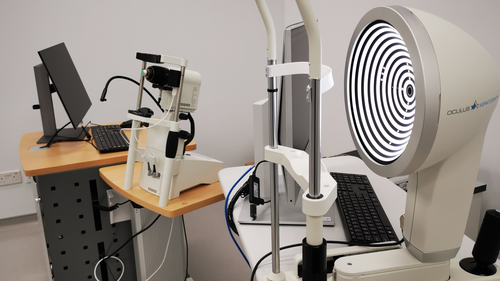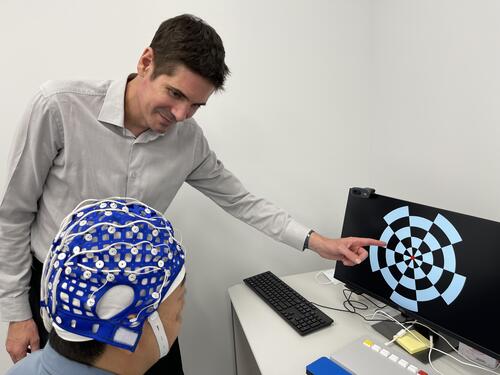The University of Waterloo's global hub for eye and vision research is taking on some of vision science's most pressing challenges through five strategic research programs aimed to generate technologies to prevent vision loss and preserve healthy vision.
The Centre for Eye and Vision Research (CEVR), located in Hong Kong's Science and Technology Park (HKSTP), is one of twenty-eight InnoHK global research centres funded by the Hong Kong government's multibillion-dollar InnoHK initiative pairing top ranking global universities with local Hong Kong institutions. CEVR is unique among these InnoHK centres as one of only three equal partnerships between the Hong Kong institute and the global university, solidifying Waterloo's School of Optometry and Vision Science as a leading global institution in vision research ranking fifth in the world.
For Bob Lemieux, Waterloo's dean of Science, one of the most exciting aspects of CEVR's location is the increased opportunity for learning and collaboration amongst researchers from many global institutions in one place.
"International collaborations are becoming the standard for addressing societal needs," says Lemieux. "While CEVR is focused on the biggest challenges in vision science, there are other InnoHK centres next door to CEVR working on health-related areas like neurodegenerative diseases, microbiology and advanced biomedical instrumentation. They each operate in the larger entrepreneurial ecosystem of Hong Kong Science Park to build an incredible pool of talent and hopefully one in which we'll be able to cross-fertilize and develop new collaborations in health-based research."
Translating research into a commercialized and sustainable business model is CEVR's long-term goal. Strategically positioned in one of Asia's diverse start-up ecosystems, technologies developed at CEVR will first be approved in China and Hong Kong, leading to greater commercialization opportunities in the Asian market where rates of myopia and dry eye disease are high.
First global study on dry eye disease
At CEVR, Waterloo's Dr. William Ngo is working alongside a research team to comparatively characterize the microbiome and biochemistry of the ocular surface between the Asian and Canadian populations. With these findings, Dr. Ngo and PolyU's Dr. Thomas Lam will identify novel markers that can be used to develop new technologies to treat and prevent dry eye.
Dr. Ngo says this research is the only comparative study of dry eye disease that has been executed on a global scale.
 "Bringing together our clinical and basic sciences expertise from both sides of the world has been critical in helping us to identify what differences exist and how risk factors differ between the two populations," Ngo says.
"Bringing together our clinical and basic sciences expertise from both sides of the world has been critical in helping us to identify what differences exist and how risk factors differ between the two populations," Ngo says.
As part of its five-year plan, one of CEVR's goals is to leverage their expertise to create the world's first centre dedicated exclusively to dry eye research and prevention.
Tackling the largest challenges in vision science
Myopia (commonly known as nearsightedness) is a condition where the eye grows too long, causing blurred vision and increasing the risk of serious eye disease later in life. Myopia prevalence is on the rise across the globe - particularly in Asian populations - and is increasing the risk of vision loss. Despite its prevalence, the cause of myopia is still unknown. Led by Waterloo's Dr. Deborah Jones, researchers at CEVR are leading the world in the development of technologies that slow, prevent or reverse myopia progression to preserve eye health.
Delivery of drugs to the eye remains a significant challenge for drug formulation scientists. Developing solutions for drug delivery, especially to the back of the eye, has been identified as a key unmet need by eyecare practitioners world-wide. Dr. Lyndon Jones' (Waterloo) research at CEVR relates to the development of new technologies to deliver sight-saving drugs to both the front and the back of the eye, for a wide variety of diseases, including ocular allergy, microbial keratitis, age-related macular degeneration and diabetic retinopathy, through eye drops, ocular surface inserts and contact lenses.
Older adults are becoming increasingly at risk for vision problems such as age-related macular degeneration, glaucoma and the effects of stroke. Older adults are becoming increasingly at risk for vision problems such as age-related macular degeneration, glaucoma and the effects of stroke. Waterloo's Dr. Tammy Labreche and Dr. Susan Leat are developing new techniques to assess the impact of stroke and create new approaches to management and rehabilitation to improve quality of life.

Dr. Ben Thompson, CEO of CEVR and University of Waterloo faculty member, working with a patient in the CEVR clinic.
Research in optometric technology is crucial for the maintenance of healthy vision in the aging population. At CEVR, a new type of non-invasive eye scan developed and patented by Professor Melanie Campbell of Waterloo's Department of Physics and Astronomy is using polarized light to highlight deposits called amyloid proteins found at the back of patients' retinas decades before they experience cognitive decline from brain diseases like Alzheimer's.
Despite the distance, collaboration between Waterloo and PolyU has been key to CEVR's early success in global vision research, says the Centre's CEO Dr. Ben Thompson.
"By assembling a team of world-leading researchers across two internationally renowned institutions, CEVR is allowing us to significantly advance eye and vision health in Canada, Hong Kong and world-wide."






